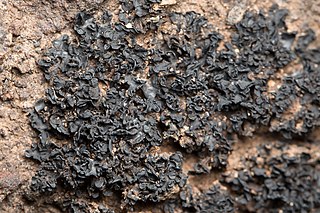
The Catillariaceae are a family of crustose lichens in the order Lecanorales. Species of this family have a widespread distribution, especially in temperate areas. The family was originally circumscribed by Austrian lichenologist Josef Hafellner in 1984.

The Lecanoraceae are a family of lichenized fungi in the order Lecanorales. Species of this family have a widespread distribution.

Scoliciosporaceae is a family of lichen-forming fungi in the order Lecanorales. It contains two genera, the monotypic Umushamyces, and the type genus Scoliciosporum. The family was circumscribed by lichenologist Josef Hafellner in 1984.
Adelolecia is a genus of crustose lichens in the family Lecanoraceae. The genus was circumscribed by Hannes Hertel and Josef Hafellner in 1984. The genus was formerly classified in the family Ramalinaceae, but molecular phylogenetic analysis showed it to belong to the Lecanoraceae.

The Lichinaceae are a family of ascomycete fungi. Most species are lichenized with cyanobacteria, and have a distribution largely in temperate regions.
Gyrophthorus is a genus of lichenicolous (lichen-dwelling) fungi in the phylum Ascomycota. The relationship of this taxon to other taxa within the phylum is unknown, and it has not yet been placed with certainty into any class, order, or family. The genus was circumscribed in 1990 by Josef Hafellner and Leopoldo Sancho, with Gyrophthorus perforans assigned as the type species.
Cladidium is a genus of two species of lichen in the family Lecanoraceae. Cladidium was circumscribed by Josef Hafellner in 1984 with C. thamnitis assigned as the type species. C. bolanderi was added to the genus in 1989.

The Lecideaceae are a family of lichens in the order Lecideales.

Clauzadea is a genus of lichenized fungi in the family Lecideaceae. The genus contains four species found in Europe. Clauzadea was circumscribed in 1984 by lichenologists Josef Hafellner and André Bellemère.

Ropalospora is a genus of lichen-forming fungi, and the sole member of the monogeneric family Ropalosporaceae. The genus was circumscribed by Italian lichenologist Abramo Bartolommeo Massalongo in 1860. The family was proposed by Josef Hafellner in 1984.

Hypocenomyce is a genus of lichen-forming fungi in the family Ophioparmaceae. Species in the genus grow on bark and on wood, especially on burned tree stumps and trunks in coniferous forest. Hypocenomyce lichens are widely distributed in the northern hemisphere.
Megalaria is a genus of lichen-forming fungi in the family Ramalinaceae. The genus was circumscribed by Austrian lichenologist Josef Hafellner in 1984, with Megalaria grossa assigned as the type species.

Haematomma is a genus of crustose lichens established by Abramo Bartolommeo Massalongo in 1852. It is the sole genus in the Haematommataceae, a family circumscribed by Josef Hafellner in 1984. Commonly called bloodstain lichens, the species assigned to this genus are widely distributed in tropical and temperate areas.

The Tephromelataceae are a family of lichenized fungi in the order Lecanorales. The family was circumscribed by Austrian lichenologist Josef Hafellner in 1984. Tephromelataceae comprises the genera Tephromela, Calvitimela, Mycoblastus and Violella, which together constitute a well-supported monophyletic group.

Protoparmelia badia is a species of crustose lichen in the family Parmeliaceae. It is a widely distributed, common species that grows on rocks.
Josef Hafellner is an Austrian mycologist and lichenologist. He was awarded the Acharius Medal in 2016 for his lifetime contributions to lichenology. Before his retirement, he was a professor at the Karl-Franzens-Universität in Graz. Hafellner started developing an interest in lichens while he was a student at this institution, studying under Josef Poelt. He earned a master's degree in 1975 and a PhD in 1978, defending a doctoral thesis about the genus Karschia. In 2003, Hafellner received his habilitation. By this time, he had studied with French lichenologist André Bellemère (1927–2014) at Saint-Cloud, where he learned techniques of transmission electron microscopy and how their application in studying asci could be used in lichen systematics. His 1984 work Studien in Richtung einer natürlicheren Gliederung der Sammelfamilien Lecanoraceae und Lecideaceae has been described as "probably the single most influential publication in lichen systematics in the latter half of the 20th century".
Placolecis is a genus of lichen-forming fungi in the family Catillariaceae. It has four species of saxicolous (rock-dwelling) and crustose lichens. The genus was circumscribed by Italian botanist Vittore Benedetto Antonio Trevisan de Saint-Léon in 1857. He did not assign a type species for the genus. Josef Hafellner designated a lectotype for Placolecis balanina in 1984, but subsequently, this taxon was folded into P. opaca.
Harpidiaceae is a small family of lichen-forming fungi, containing two genera and five species. It is of uncertain classification in the Pezizomycotina.

Sarrameanaceae is a family of lichen-forming fungi in the monotypic order Sarrameanales. It contains two genera, Loxospora, and Sarrameana, the type genus. The family was circumscribed by Josef Hafellner in 1984. The order Sarrameanales was proposed by Brendan Hodkinson and James Lendemer in 2011, as they had noted that previously published large-scale molecular phylogenetic studies had shown that the group of species contained in the family Sarrameanaceae were distinct and separate from the clade containing all of the other orders of the Ostropomycetidae. However, the name Sarrameanales was not validly published according to the rules of botanical nomenclature, because it was not accompanied by a suitable description. Despite this, the order continues to be used in lichenological literature.
Timdalia is a fungal genus in the family Acarosporaceae. It is a monotypic genus, containing the single species Timdalia intricata, a saxicolous (rock-dwelling), crustose lichen. This species was first formally described by Swedish lichenologist Adolf Hugo Magnusson in 1935, based on a collection made by Eduard Frey in Austria. It was initially classified in the genus Acarospora. Josef Hafellner circumscribed Timdalia to contain the species in 2001. It was initially placed in the family Lecanoraceae, but molecular phylogenetic studies showed Timdalia to belong in the Acarosporaceae. The genus name honours Norwegian lichenologist Einar Timdal.











